Royal Zoute Golf Club
Knokke-Heist, Belgium
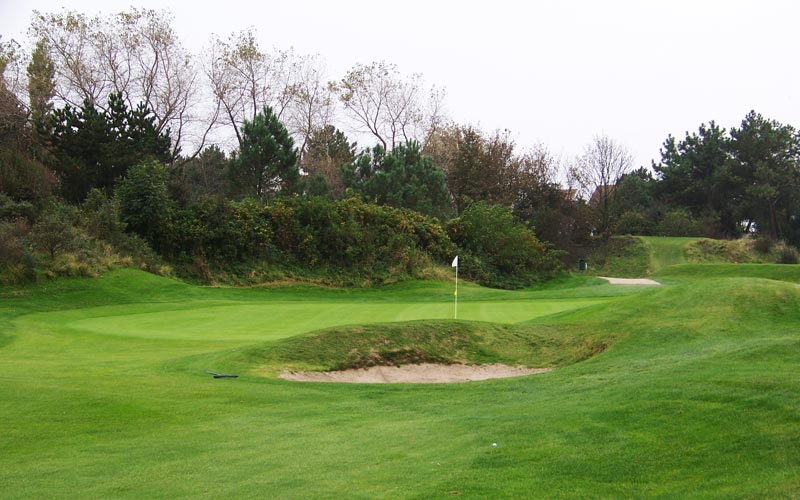
At under 6,800 yards in length, Royal Zoute is more about placement than brute strength. Pictured above is an approach that came up short at the 385 yard tenth, leaving an awkward recovery.
Given Belgium’s coastline along the English Channel as well as its proximity to London from which so many great golf architects emanated,it is not a surprise that Royal Zoute Golf Club enjoys one of Europe’s richest golf histories.
Around the turn of the twentieth century, British residents played golf in the sand dunes near the wealthy Belgium resort town of Knokke. Count Maurice Lippens, the chairman of Compagnie Immobiliere du Zoute which owned the dunes and much of the surrounding land, realized the attraction of the sport and what it could mean for the area. In 1908, he formed what is now called Royal Zoute Golf Club (the Royal appellation wasn’t added until the 1920s).
To build the golf courses,Count Lippens brought in Harry Colt, who had established himself in a relatively brief time as belonging with such men as Herbert Fowler and Willie Park Jr. as the best at constructing golf courses that were natural in appearance. Colt at the time still held the powerful possession as Secretary of the prestigious Sunningdale Golf Club in Surrey, England but he was progressively spending more time advising on the construction of golf courses. Keen to establish himself on the Continent, Colt was quite pleased to earn the commission of the two courses that he built for Count Lippens between 1910 and 1913. They were among the first he built on the Continent; for instance, his famed work that transformed the Netherlands didn’t commence for another fifteen years, in part due to World War I.
Count Lippens accurately read how popular golf would prove to be. In 1921,he brought Colt back to build a third course. Referred to as St. Andre, this course was Colt’s Belgium masterpiece. As seen in this 1939 ranking as found by Tom MacWood, St. Andre, also refered to as Knocke, at its height was considered among the world top thirty courses. It was located fifteen kilometers from today’s Royal Zoute and had the physical advantage of being located directly along the dunes of the English Channel. Historian Tom MacWood found this classic passage written in 1923 byBernard Darwin in regards to St. Andre:
Early in the present year I was walking with HS Colt over a beautiful park near London, out of which he had evolved three courses that already are giving pleasure to several hundred players of both sexes. I offered Mr. Colt my warm congratulations on the result of his labours, which he acknowledged with the remark, ‘I am glad you like the courses, but you should see the golfing country I am working on over in Belgium. I think it is the best I have ever seen.’ Coming from him, I realized at once that here was something out of the common, and when a few days ago, I received an invitation to go and see it with him, I accepted with the joy of anticipation that one keeps for a treat…I was not prepared, however, even after Mr. Colt’s praise, for the wonders he was to show me. Add to the characteristics, very similar to those at St.Andrews, a modification of the best features of Prestwick and Prince’s, and an individuality all its own, and you will have some idea of the nature of the links, most happily and worthily named St.Andre.
Sadly, all three courses were destroyed in World War II and St. Andrewas gone forever. Of all of Colt’s European work, its loss may be considered the greatest.
Fortunately though, in no small part thanks to Lieutenant Colonel Allen, golf resumed at the two inland courses of Royal Zoute in 1947. The championship course that is profiled here plays along the perimeter of the club’s property whereas the par 64 competition course is within the loop created by the big course. Colt had a propensity for creating loops within loops, be it eighteen hole loops like here, or nine holes within another nine hole loop ala Kennemer and Muirfield. One reason that he did so is that as the holes tack around the perimeter, generally no more than two play consecutively in the same direction. Thus, the golfer always needs to make allowances for shifts in wind direction.
Holes To Note
Third hole, 150 yards; Paul Turner, noted Colt historian, is quick to point out that the third hole isn’t found on a 1928 course routing that appeared in a European golf guide entitled ËœGuides Plumon-Les golfs du Continent.’ Colt never returned here after 1928, so today’s third isn’t one of Colt’s creations. Unfortunately, that is all that is known for certain. Did Lieutenant Colonel Allen have any involvement in the hole’s formation? Or perhaps credit belongs to John Morrison who came here after World War II? Regardless, the long pushed-up green is one of the most vexing targets to hit on the entire course as it is only fourteen paces wide at the back and even narrower in the front. Recovery is quite ticklish from the sides as the green slopes away both left and right. Indeed, the author can attest to the maddening qualities of this built-up green as he watched his opponent ping-pong his recovery shots from side to side.
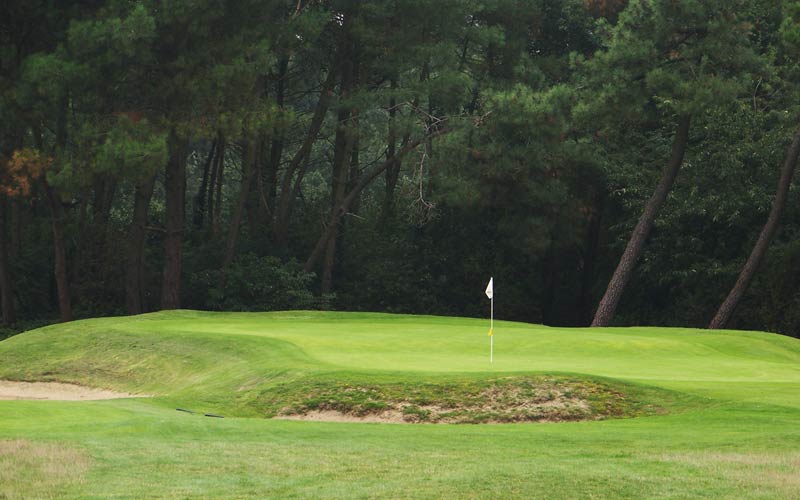
The third green doesn’t appear on a 1928 routing. Regardless of who and when it was built, the long and narrow green has vexing playing characteristics.
Fifth hole, 480 yards; A blind drive over a ridge at the fourth signifies the start of promising golf country and Colt’s work at Royal Zoute is fully realized at the fifth where he placed the fairway in the valley between two rows of dunes. As the valley, and fairway, bend toward the left, a pair of bunkers pinch the fairway in one hundred yards from the green, creating all kinds of decisions. Can the golfer carry past these bunkers as well as the deep cross bunker forty yards from the green? If so, a birdie or better may await. Or perhaps the wind is against and it is best to lay back today? If so, to where? So many decisions make this a great half par hole that all club golfers never tire of tackling.
Seventh hole, 390 yards; As opposed to the fifth through a valley, the seventh fairway bobs up and down over interesting undulations. At this point in the round, comparisons with Royal Lytham & St. Annesmay be drawn as the land is well suited for golf without being tumbling and red brick houses are periodically seen out of bounds along the perimeter. After leaving this green, the longest green to tee walk on the course takes the golfer to the best links land, with the dunes bigger and wilder and the sense of trees dissipates.
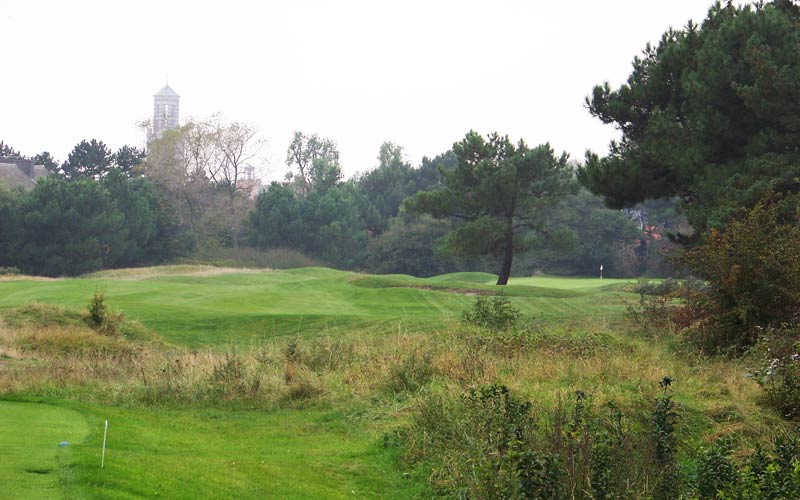
As seen from the seventh tee, Royal Zoute enjoys a seaside flavor that is derived from its undulating (though never hilly) land and gnarly vegetation.
Tenth hole, 385 yards; Given the windy locale,this hole’s modest distance can be a fooler. The entire play of the hole spins around whether the golfer can carry a large land form with a bunker cut into its top on the inside of this dogleg to the left. If the golfer can carry it (which assumes the wind isn’t coming in hard off the Channel), then he is left with a relatively simple pitch down the length of the green. However,on those windy days and for those with more modest ambitions,an approach from the right center of the fairway to this front left to back right angled green is much harder to judge.

The ideal line off the tenth tee is toward the steeple in the distance but that requires a carry of 230 yards over the large landform. As the golfer plays to the right of that…
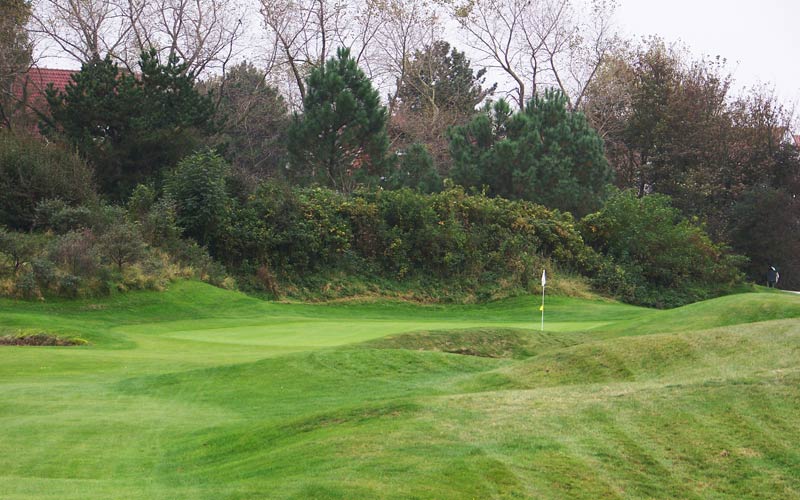
…the angle into the green becomes more ticklish. A drive long left though beautifully opens up an approach down the spine of the angled green.
Eleventh hole, 210 yards; Routing a course around a property’s perimeter always leads to a couple (or more!) tight spots as it is easy for the architect to in advertently get boxed in around the corners. Such is not the case here in the northwest corner of the property. When initially walking the property, and ever mindful of finding par three holes first, Colt found a natural tee site atop the tallest dune on the property. Two hundred yards away toward the corner of the property was a natural green site and this tough one shotter was born. The exposed tee is as windy as any spot on the course and as such, the golfer that controls the flight of his ball is amply rewarded.
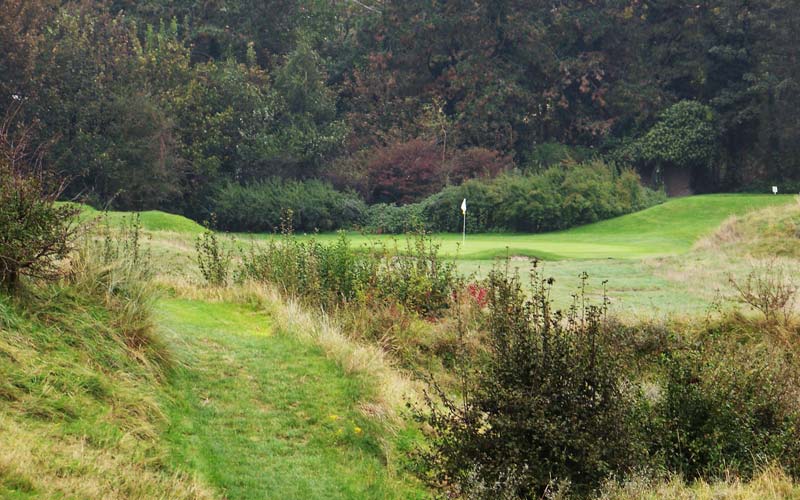
Colt placed the tee a top this dune to the left and located the eleventh green in a natural pocket in the corner of the property.
Twelfth hole, 535 yards; Like the third hole, the origins of this zig-zag par five are a mystery. The previously mentioned 1928 stick routing shows this as being two straight par fours when Colt was here. At some point, probably after World War II, the holes were combined into this most appealing par five. Again, who deserves the credit remains unknown but the Club should be congratulated for being a good steward and letting the hole evolve as it has. Today’s drive must find the fairway of what was once the first par four.Given a good lie in the fairway, the golfer is free to cross over a ridge and head in the general direction of the green. A good second shot finds him in the fairway of the second par four that Colt created, or perhaps near the green itself, which is sharply sloped from front to back.To create these various playing angles within a hole that borders the straight line of the perimeter is laudable. Another interesting result of combining the two par fours is that the course now finishes with three par fives in the its last seven holes, making for plenty of potential match-swinging moments.

Colt’s twelfth, a par four, originally ran in the direction of the red roof. While the tee shot is still aimed in that general direction, today’s par five twelfth now swings left toward the green in the left middle of the photograph above.
Thirteenth hole, 450 yards; There are many courses more dramatic than Royal Zoute. After all, the course is landlocked and is situated two kilometeres from the English Channel. However, few courses are blessed with land so ideally suited to the game of golf as the property is rife with three to twelve feet tall undulations throughout. Fortunately, its architect(s) put the land to great use and there is no better example than here at the thirteenth. Colt swung the fairway down and to the left after crossing a ridge line. From there, it meanders up through a valley to a bunkerless green. Indeed, the entire hole is bunkerless, a sure sign that the property was excellent (and a compliment to the architects for leaving well enough alone).
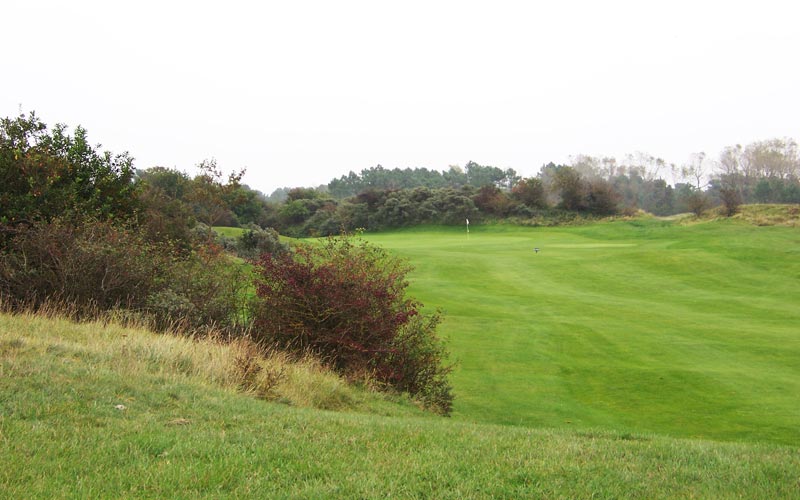
The thirteenth hole swings to the left with its fairway running through a valley for the last two hundred yards. What a pity that more courses don’t enjoy such a clean, uncluttered hole.
Fourteenth hole, 360 yards; Royal Zoute is never about brute force. Far better, it relies on subtle angles instead. Another case in point is here at the fourteenth, the shortest par four on the course, where the ideal tee ball rubs past a steep hillside 220 yards from the tee, at the base of which is a penal bunker. As the golfer shies away from the challenge presented by that bunker, the approach to the angled green becomes progressively difficult, thanks to its left greenside bunkers and wicked false front.
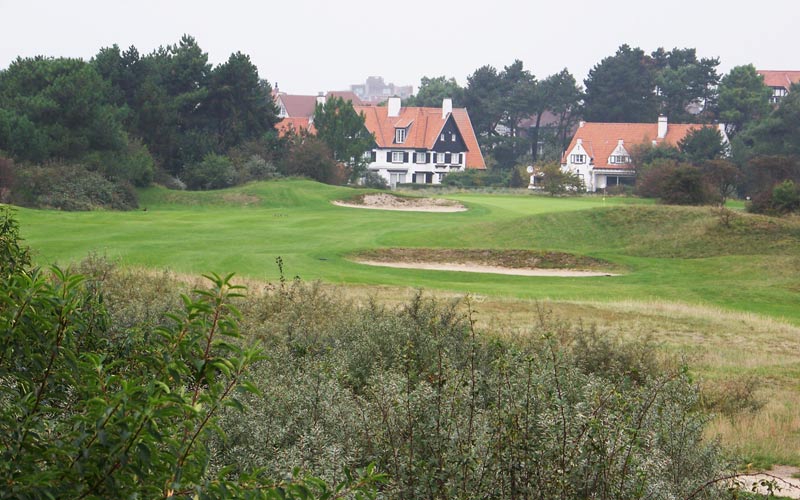
Another clever play of angles is off the fourteenth tee. The bunker and landform on the right guard the best line into the green.
Sixteenth hole, 185 yards; Modern courses, especially those that were built with hopes of staging an event for television, invariably possesses a par three hole in its final three holes with water as the ubiquitous hazard. Clearly, a hit or miss target like a par three green lends itself to drama. Coming at the end of the round, the pressure is likely to be at its highest, so it makes for great theater. Of course, the catch with water is that in general it is a non-recoverable hazard. Perhaps drama would be better served by using hazards that at least give the golfer a chance of recovery. After all, recovery shots are often more nervy to execute than full shots.
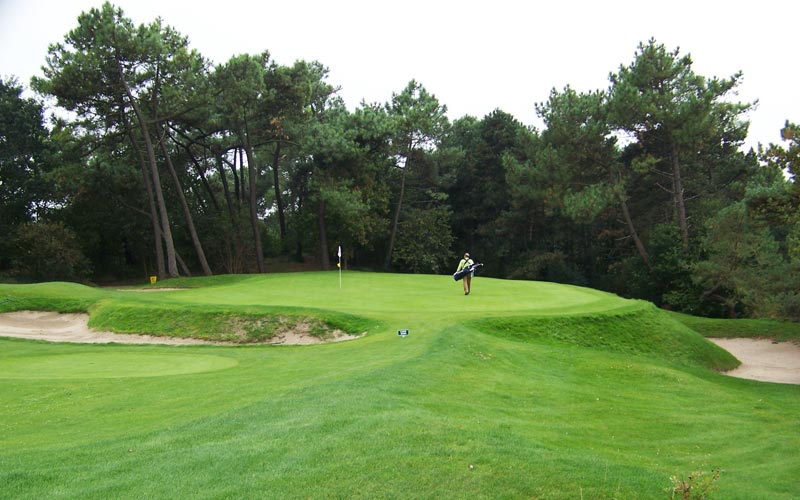
Hitting the built-up sixteenth green is most satisfying. Missing the green leaves a taxing recovery from all sides but at least the golfer is given the chance to show his recovery skills.
The penultimate hole is a straightaway par five that requires little more than straight hitting. The Home hole though makes up for it as its green contains the best interior contours of any on the course. As such, it makes for a fitting conclusion to this clever course where shots are never quite as simple as they first appear. Like the Old Course at St. Andrews, one’s appreciation of Royal Zoute gains with each round, thanks in particular to its three to seven foot undulations that are rife throughout the course and that Colt incorporated so well into his routing.Plenty of modern designs may be more dramatic but they lack the inherent golf qualities that such topography provides.
The End


